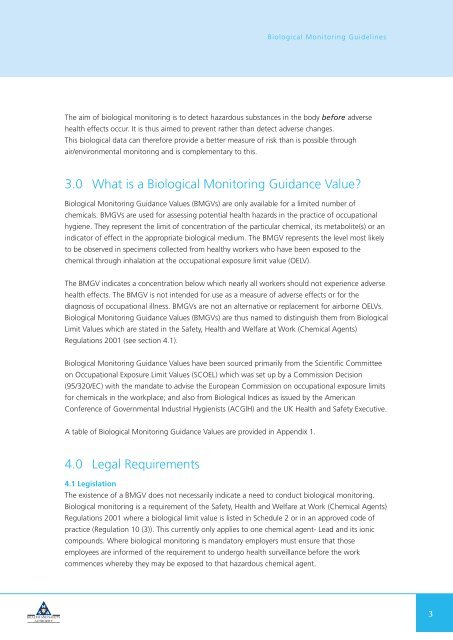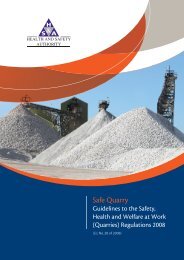Biological Monitoring Guidelines - Health and Safety Authority
Biological Monitoring Guidelines - Health and Safety Authority
Biological Monitoring Guidelines - Health and Safety Authority
Create successful ePaper yourself
Turn your PDF publications into a flip-book with our unique Google optimized e-Paper software.
<strong>Biological</strong> <strong>Monitoring</strong> <strong>Guidelines</strong><br />
The aim of biological monitoring is to detect hazardous substances in the body before adverse<br />
health effects occur. It is thus aimed to prevent rather than detect adverse changes.<br />
This biological data can therefore provide a better measure of risk than is possible through<br />
air/environmental monitoring <strong>and</strong> is complementary to this.<br />
3.0 What is a <strong>Biological</strong> <strong>Monitoring</strong> Guidance Value?<br />
<strong>Biological</strong> <strong>Monitoring</strong> Guidance Values (BMGVs) are only available for a limited number of<br />
chemicals. BMGVs are used for assessing potential health hazards in the practice of occupational<br />
hygiene. They represent the limit of concentration of the particular chemical, its metabolite(s) or an<br />
indicator of effect in the appropriate biological medium. The BMGV represents the level most likely<br />
to be observed in specimens collected from healthy workers who have been exposed to the<br />
chemical through inhalation at the occupational exposure limit value (OELV).<br />
The BMGV indicates a concentration below which nearly all workers should not experience adverse<br />
health effects. The BMGV is not intended for use as a measure of adverse effects or for the<br />
diagnosis of occupational illness. BMGVs are not an alternative or replacement for airborne OELVs.<br />
<strong>Biological</strong> <strong>Monitoring</strong> Guidance Values (BMGVs) are thus named to distinguish them from <strong>Biological</strong><br />
Limit Values which are stated in the <strong>Safety</strong>, <strong>Health</strong> <strong>and</strong> Welfare at Work (Chemical Agents)<br />
Regulations 2001 (see section 4.1).<br />
<strong>Biological</strong> <strong>Monitoring</strong> Guidance Values have been sourced primarily from the Scientific Committee<br />
on Occupational Exposure Limit Values (SCOEL) which was set up by a Commission Decision<br />
(95/320/EC) with the m<strong>and</strong>ate to advise the European Commission on occupational exposure limits<br />
for chemicals in the workplace; <strong>and</strong> also from <strong>Biological</strong> Indices as issued by the American<br />
Conference of Governmental Industrial Hygienists (ACGIH) <strong>and</strong> the UK <strong>Health</strong> <strong>and</strong> <strong>Safety</strong> Executive.<br />
A table of <strong>Biological</strong> <strong>Monitoring</strong> Guidance Values are provided in Appendix 1.<br />
4.0 Legal Requirements<br />
4.1 Legislation<br />
The existence of a BMGV does not necessarily indicate a need to conduct biological monitoring.<br />
<strong>Biological</strong> monitoring is a requirement of the <strong>Safety</strong>, <strong>Health</strong> <strong>and</strong> Welfare at Work (Chemical Agents)<br />
Regulations 2001 where a biological limit value is listed in Schedule 2 or in an approved code of<br />
practice (Regulation 10 (3)). This currently only applies to one chemical agent- Lead <strong>and</strong> its ionic<br />
compounds. Where biological monitoring is m<strong>and</strong>atory employers must ensure that those<br />
employees are informed of the requirement to undergo health surveillance before the work<br />
commences whereby they may be exposed to that hazardous chemical agent.<br />
3
















